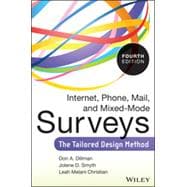For over two decades, Dillman's classic text on survey design has aided both students and professionals in effectively planning and conducting mail, telephone, and, more recently, Internet surveys. The new edition is thoroughly updated and revised, and covers all aspects of survey research. It features expanded coverage of mobile phones, tablets, and the use of do-it-yourself surveys, and Dillman's unique Tailored Design Method is also thoroughly explained. This invaluable resource is crucial for any researcher seeking to increase response rates and obtain high-quality feedback from survey questions. Consistent with current emphasis on the visual and aural, the new edition is complemented by copious examples within the text and accompanying website.
This heavily revised Fourth Edition includes:
- Strategies and tactics for determining the needs of a given survey, how to design it, and how to effectively administer it
- How and when to use mail, telephone, and Internet surveys to maximum advantage
- Proven techniques to increase response rates
- Guidance on how to obtain high-quality feedback from mail, electronic, and other self-administered surveys
- Direction on how to construct effective questionnaires, including considerations of layout
- The effects of sponsorship on the response rates of surveys
- Use of capabilities provided by newly mass-used media: interactivity, presentation of aural and visual stimuli.
- The Fourth Edition reintroduces the telephone—including coordinating land and mobile.
Grounded in the best research, the book offers practical how-to guidelines and detailed examples for practitioners and students alike.








